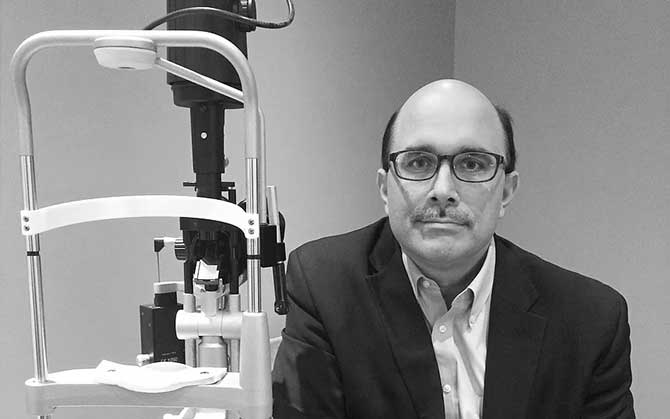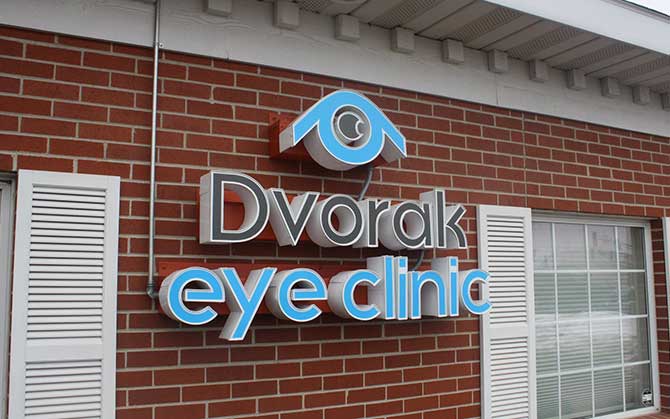Cataracts: Signs, Symptoms, and Treatment

While cataract is a well-known term, many find themselves fuzzy on what a cataract actually is. The key term in the above sentence being “fuzzy,” a cataract is a cloudiness of the natural lens of the eye. As Dr. John A. Dvorak of Dvorak Eye Clinic explains, “Essentially, a cataract acts like a dirty window for your eye.”
Dr. Dvorak is no stranger to Ophthalmology. He opened Dvorak Eye Clinic in March of 2017 and has over 20 years of experience in conventional cataract surgery, laser-assisted cataract surgery, LASIK, PRK, laser eye surgery, and any comprehensive ophthalmic surgery. Dr. Dvorak sat down with us to explain the symptoms and treatments for cataracts.

How do I know if I have a cataract?
As you grow older, your eye becomes cloudy from age and sunlight. You may notice yourself having a hard time seeing road signs, having trouble reading the newspaper, or experiencing glare from oncoming cars. These are all signs you may have a cataract in one or both eyes.
Cataracts typically occur simultaneously in both eyes and advance at the same slow rate. This gradual progression can make it difficult for the patient to notice they are not seeing as clearly as they used to, but when they take one cataract out, they can immediately tell a difference. “It can truly be an eye-opening experience,” joked Dr. Dvorak.
As almost everyone will have some form of cataract once they are in their 60s and beyond, it is important to schedule annual visits to the eye doctor. The American Academy of Ophthalmology recommends yearly exams after age 50. Once a cataract is identified, a thorough exam from Dr. Dvorak can identify how advanced the cataract is and if surgery would be beneficial.
What does cataract surgery look like?
Getting a cataract taken out is an elective process. Everybody’s eyes are different, so there are no set criteria for if cataract surgery is needed or not. A large portion of the decision boils down to how much the cataract is impacting the patient’s daily life. As Dr. Dvorak describes, “Having poor sight can be a detriment and can affect your life in many ways.”
Many years ago, cataract surgery was a traumatic event. Patients had to spend days in the hospital and sandbags were placed around the patient’s head to keep them steady. In the early 80s, however, there were huge advances in how cataract surgery is performed.
Now, cataract surgery only takes around 10 minutes for the whole procedure and demonstrates a 99% success rate. All that is needed is to make a small incision in the eye, take out the cloudy lens, and replace it with an artificial lens. Patients are sedated during surgery, so there is no pain during the procedure.
Recovery is quick with some patients seeing better the next day. There can be some scratchiness and irritation post-surgery, with some patients describing it as feeling like a rock under their lid. This typically doesn’t last long and Ibuprofen and Tylenol can usually take away the irritation. After a few days, there are no restrictions at all.
Post-operative visits are recommended a week or two out and again after a month or two. Patients are able to see Dr. Dvorak or their regular eye doctor for these visits.
Why St. Cloud Surgical Center?
While Dvorak clinic is utilized for pre and post-operative evaluations, Dr. Dvorak performs his local surgeries at the St. Cloud Surgical Center. As he expresses, “St. Cloud Surgical Center is one of the most unique surgical centers throughout the country. They excel at what they do in service, satisfaction, equipment, and they are very sensitive to the needs not only of the patient but also of the doctor.”
We are excited to welcome Dr. Dvorak to the St. Cloud Surgical Center for our free Ophthalmology seminar on September 24th, 2018. He will be expanding even further on cataracts and the incredible surgical advancements cataract treatment has taken in the last few years.
You can sign-up and learn more here: facebook.com/events/239968946679322/